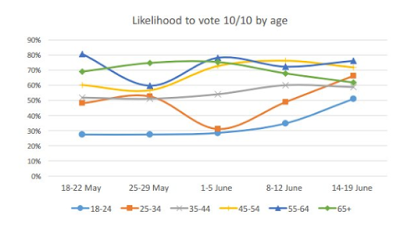The Young Need to Turnout to Vote

Please note that we are not authorised to provide any investment advice. The content on this page is for information purposes only.
We showed that younger age cohorts in the UK are more inclined to vote to stay in the EU than their elders. However, some suggested that this consideration is blunted by the fact that the younger people are less likely to vote.
That may have been the case, but as this Great Graphic of intention by the pollster ORB (h/t @joshTANoble) shows, the situation is more dynamic.
We showed that younger age cohorts in the UK are more inclined to vote to stay in the EU than their elders. However, some suggested that this consideration is blunted by the fact that the younger people are less likely to vote.
That may have been the case, but as this Great Graphic of intention by the pollster ORB (h/t @joshTANoble) shows, the situation is more dynamic.
Since the start of the month, there appears to have been a dramatic increase in the number of the two youngest cohorts who intend to vote.
The percentage of the youngest cohort (18-24) has more than doubled, though is still the lowest expected participation rate. The next youngest cohort (25-34) has also more than doubled and now stands above the cohort just ahead of them (35-44) and the oldest cohort (65+).
Of note, there results detect a decline in the percentage of older (65+) and a middle age (45-54) cohort. In the UK, there are roughly 17 mln people in the UK aged 19-40. There are almost 13 mln people in the UK aged 60-90.
There are of course other ways to fissures among UK voters, though the demographic divide seems particularly useful. The turnout is important.
Great Graphic: UK Referendum–Turnout it Key is republished with permission from Marc to Market





